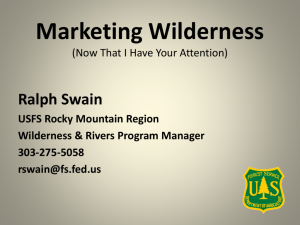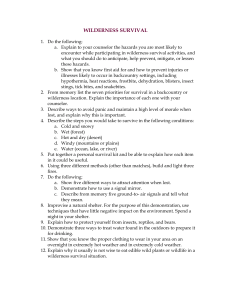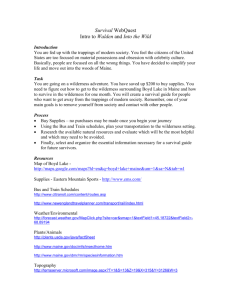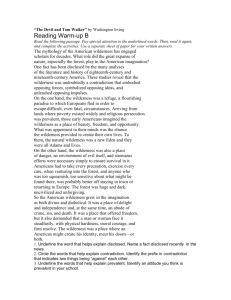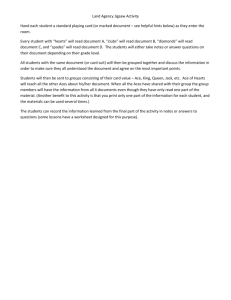Wilderness, Water, and Climate Change
advertisement
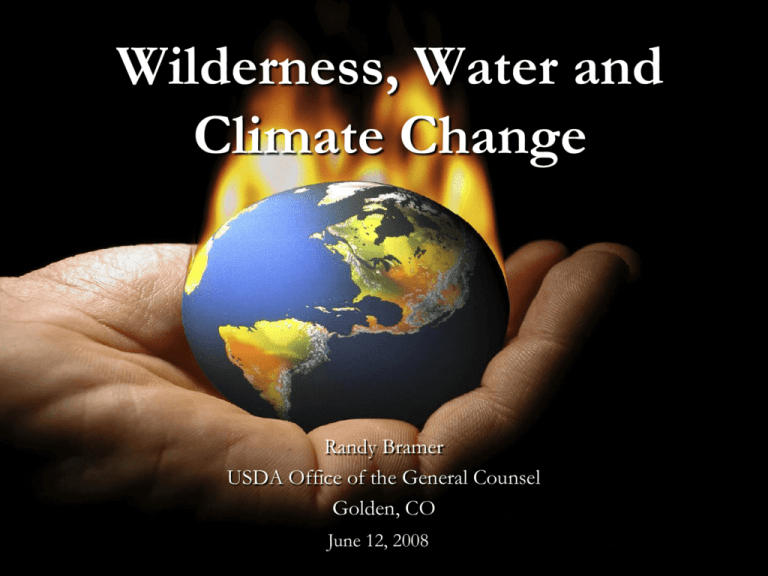
Wilderness, Water and Climate Change Randy Bramer USDA Office of the General Counsel Golden, CO June 12, 2008 Issues What are the potential effects of climate change on water? How will these changes affect wilderness? What can you do? Water Is A Scarce Resource Water Is A Scarce Resource In High Demand “Today, in some areas of the West, existing water supplies are, or will be, inadequate to meet the water demands of people, cities, farms, and the environment even under normal water supply conditions.” U.S. Department of the Interior, “Water 2025: Preventing Crisis and Conflict in the West” (2003) While the U.S. is relatively water rich, the western part of the nation -where most National Forests are located -- is water poor. Demand For Water Will Increase Population of the West has increased 50% in the last 20 years and is expected to increase another 300% by 2040. What are the Potential Impacts of Climate Change on Water? Climate Change Overall temperatures in the Rockies — and around the world — are rising dramatically. The Intergovernmental Panel on Climate Change reports that global mean surface temperature increased by 0.6 degrees Celsius (about 1 degree Fahrenheit) over the 20th century. In the Western Hemisphere, the warming was greater than in any other century for the last 1,000 years, and the 1990s were the warmest decade of the entire millennium. The IPCC, which issued its most recent assessment report in 2001, now predicts that global mean temperatures will rise anywhere from 1.5 to 5.8 degrees Celsius (2.5 to 10.4 degrees Fahrenheit) between 1990 and 2100 — a rate of warming very likely without precedent in the last 10,000 years. Climate Change and Water “What do you really need to tell people about climate change and water? It’s getting hotter. We’ll get less snow. The snow will melt earlier. That’s all you need to say.” Climate Change - Effects on Southwest Water Resources, Southwest Hydrology , January/ February 2007 Climate Change & Water - The Global Picture Climate change means that creeping deserts may eventually drive 135 million people off their land, the United Nations estimates. Most of them are in the developing world. But Southern Europe is experiencing the problem now, its climate drying to the point that it is becoming more like Africa’s, scientists say. In Spain, Water Is a New Battleground, NY Times, June 3, 2008 Water Is Likely to Get Scarcer Due to Climate Change – North America The Intergovernmental Panel on Climate Change concludes that climate change will strain many of North America’s water resources, increasing the competition for water. A warmer climate will affect the seasonable availability of water by increasing evaporation and reducing snowpacks. The Columbia River and other heavily used water systems of western North America are expected to be particularly vulnerable. Groundwater-based systems in the Southwest are also likely to be stressed by climate change. Heavier precipitation will very likely increase waterborne diseases and affect water quality, and higher variability of precipitation will make water management more difficult. Possible Water Resources Impacts in North America, Climate Change – Health and Environmental Effects, EPA, December 20, 2007 Impacts of Climate Change on Water in the West More heat Smaller snowpacks Earlier snowmelt More evaporation and dryness More flood-control releases Less groundwater More legal restrictions More droughts Less Snow, Less Water: Climate Disruption in the West, September 2005, Stephen Saunders and Maureen Maxwell, The Rocky Mountain Climate Organization. West and Southwest Likely reduction in snowpacks and seasonal shifts in runoff patterns Possible declines in groundwater recharge reduced water supplies Increased water temperatures - further stress on aquatic species Increased frequency of intense precipitation events - increased risk of flash floods Possible summer salinity increase in San Francisco Bay and Sacramento/San Joaquin Delta Intergovernmental Panel on Climate Change, 2001, 2007 Portage Glacier Alaska 1914 Photos: NOAA Photo Collection and Gary Braasch – WorldViewOfGlobalWarming.org 2004 The entire Jackson-Blackfoot Glacier Basin in Glacier National Park was covered in a single glacier as recently as 1920. Scientists predict both will be gone by 2030. “Climate change has been linked to declining snowpacks, retreating glaciers, and changing patterns of precipitation and runoff. The evidence shows that we are entering a period of water scarcity not seen in our history. The national forests were created in part for ‘securing favorable conditions of water flows,’ the importance of which has grown as populations have grown. We can make a difference by managing national forests and grasslands to restore ecological processes and functions that support clean and healthy streams, lakes, and aquifers.” —Forest Service Chief Gail Kimbell The New War? The battles of yesterday were fought over land…. Those of the present center on oil. But those of the future — a future made hotter and drier by climate change in much of the world — seem likely to focus on water…. In Spain, Water Is a New Battleground, NY Times, June 3, 2008 How Might Climate Change Affect Wilderness? The change that is having the biggest and most obvious biological impact is the early arrival of spring. This could cause entire ecosystems to become unbalanced if species respond to the warmer weather at different rates. Worldwide, effects were also apparent in the ecosystems of oceans, lakes and rivers. Changes to the migration patterns of fish have led to them invading waters that were once too cold. Other important impacts include an increase in the extent of forest fires each year in Canada. Nature 453, 353-357 (15 May 2008 ) “By mid-century, the main pulse of the spring snowmelt runoff in the Upper Colorado River Basin is expected to come approximately two weeks earlier than at the present. By the end of the century, snowmelt runoff is expected four weeks earlier in virtually all of the six southwestern states. Run off is also expected to decrease, in part due to higher evaporation rates that come with higher temperatures.” Climate Change - Effects on Southwest Water Resources, Southwest Hydrology , January/ February 2007 Impacts on High Alpine Vegetation Climate change could make major changes in the character of our mountains and in the abundance and variety of life they support. The Rocky Mountains' famous wildflowers, meadows, and expanses of mountain-top tundra could all be greatly reduced, or perhaps almost vanish, as a result of climate change. So could many alpine species of animals and plants. “We're projecting, from these experiments, there's going to be a tremendous decline in the abundance of the flowers. You think of meadows strewn with gorgeous flowers. Many of those flowering plants are going to be decimated.'‘ Dr. John Harte, Professor of Environmental Science “Some ecosystems that are already constrained by climate, such as alpine meadows in the Rocky Mountains, are likely to face extreme stress, and disappear entirely in some places.” Climate Change Impacts on the United States (2000) Impacts on Trees Under most climatechange scenarios, forest types are predicted to shift uphill, implying that the forest that regenerates after a modern-day beetle kill may look very different from the one that came before it. For a forest, climate change means two things -- bigger fires, and lots more of them. “High-elevation forests will have a tough time coming back if they burn,” Cronn says. “The conditions necessary for seedling survival just aren’t there.” That means unless something unforeseen happens, the entire high-country ecosystem in the West is going to undergo radical change, including the dislocation of thousands of wildlife species for whom these forests are home. If and when the island forests of Conifers are lost to fire, they’re not going to reseed. Grasslands will quickly move up in elevation and take over. Devanter, P., High Country News, September 24, 2007 The White Bark Pine Whitebark pines form the roofbeam of our mountain landscapes. In the past it was too cold for mountain pine beetles to survive at higher elevations. When temperatures are increased by as little as two degree Celsius the beetles have been found to race thorugh a one year life cycle at higher elevations. Impacts on Animals – The Amphibians Researchers looked at amphibian survey records from about 50 different sites in Central and South America, charting the timing of extinction for about 70 different species of harlequin frogs. They found that these disappearances occurred in lockstep with warming global temperatures. "Disease is the bullet killing frogs, but climate change is pulling the trigger," ecologist Alan Pounds Biologists have long argued that amphibians, with their delicate, porous skins, are the proverbial canaries in the coal mine, the species most sensitive to global environmental change. Climate Change is Pulling the Trigger, High Country News, January 23, 2006 Impacts on Animals Pika, a coolweather-loving mountain rodent, is vanishing from the Sierra Nevada Natural Preservation and Global Warming “In the age of global warming, public-land managers face a stark choice: They can let national parks and other wildlands lose their most cherished wildlife. Or they can become gardeners and zookeepers.” Unnatural Preservation, High Country News, February 4, 2008 The Choices? Do we rush to rescue climate-imperiled species before it's too late? or Do we let nature take its course, quietly watching the disappearance of species that we have spent decades restoring and protecting? Unnatural Preservation, High Country News, February 4, 2008 “So professional preservationists, and the environmental movement as a whole, are left with unnatural choices: They can intervene aggressively to maintain habitat threatened by planetary warming installing sprinkler systems around California's giant sequoias, to name one suggestion floated by scientists. In the process they would become something akin to farmers and pet fanciers. They can intervene aggressively to provide huge migration paths northward for heat-threatened plants and animals. Because this would require them to help dramatically change existing ecosystems, it would turn the current conservation ethic on its head. Or they can decide to continue to use the traditional hands-off approach - and thereby allow millennia old ecosystems to die off and be replaced in ways that would never have happened naturally, if not for global warming.” Unnatural Preservation, High Country News, February 4, 2008 How Will Climate Change Affect Water Uses In Wilderness? Impacts Climate change is likely to decrease water quantity due to decreased snowpacks and seasonal shifts in runoff patterns and possible declines in groundwater recharge resulting in reduced water supplies. Climate change will also impact water quality through increased water temperatures and increased rainfall. Impacts on Water Allocation Competition for the use of limited and declining water resources in the West continues to increase. This competition will likely increase as climate change continues. With this increased competition and a corresponding increase in administrative enforcement by States, there is likely to be more pressure for water removal from federal lands on or near wilderness Decreased water availability and changes in the seasonal availability of water will directly affect how these water rights are defined and subsequently administered. Impacts on Uses of Water in or Near Wilderness Ski Areas There will likely be an increase in requests for snowmaking on NFS land. Water for these uses may come from NFS land adjacent to wildernesses. Recreation Potential increases in camping, hiking, and fishing would draw different outdoor recreation enthusiasts to the area and those activities might be available for a longer period of time during the year. US National Assessment of the Potential Consequences of Climate Variability and Change Educational Resources Regional Paper: Rocky Mountain /Great Basin Region, US Climate Change Science Program / US Global Change Research Program Impacts on Grazing Changes in availability of water and timing of runoff caused by climate change may change the locations of allotments as well as the season of use. Impacts on Water Storage Facilities “The snow pack is our major reservoir, and we don’t have artificial reservoirs sufficient in size to manage it in a way that nature manages it for us” Kathleen Miller, National Center for Atmospheric Research and author of the book “Climate Change and Water Resources: A primer for Municipal Water Providers”. Impacts on Water Storage Facilities Overall, temperature increases are expected to decrease the ability of our mountain “water towers” to reliably deliver water in the quantities we have come to expect and when we need it most. Climate Change - Effects on Southwest Water Resources, Southwest Hydrology , January/ February 2007 Water Storage Likely to be increased pressure to store and divert more water in existing facilities. Case Study: Emerald Lake Colorado Wilderness Emerald Lake Second largest natural lake in Colorado. Over 10, 000 feet in elevation. Completely within the Weminuche Wilderness. Emerald Lake An irrigation district is proposing to build a dam and reservoir on Emerald Lake. Must show: authorization to occupy NFS land right of access water right The Wilderness Act and Reservoirs (4) Water resources, reservoirs, and other facilities; grazing. Within wilderness areas in the national forests designated by this chapter, (1) the President may, within a specific area and in accordance with such regulations as he may deem desirable, authorize prospecting for water resources, the establishment and maintenance of reservoirs, water-conservation works, power projects, transmission lines, and other facilities needed in the public interest, including the road construction and maintenance essential to development and use thereof, upon his determination that such use or uses in the specific area will better serve the interests of the United States and the people thereof than will its denial... 16 USC 1133 (4)(a). Emerald Lake Small dam constructed in 1895-96 & maintained until 1930’s. Dam fell into disrepair & abandoned . If authorization were found to be valid under the 1891 Act, FS may have to provide access as “the Secretary deems adequate to secure to the owner the reasonable use and enjoyment” of its right of way. What are the Scientists Doing in Wilderness Areas? What are the Scientists Doing in Wilderness Areas? Looking at long term changes in wilderness lake chemistry Monitor ozone at high elevation in Colorado near wildernesses. Examining spatial variability in wilderness lake chemistry Water chemistry of high elevation Colorado wilderness lakes Robert C. Musselman* and William L. Slauson, Biogeochemistry 71: 387–414, 2004. What Can Wilderness Staff Do? The Need for Field Data Although there are reams of conclusive science on the “whether” of global warming—it is definitely occurring—there’s very little precise information on when, and where, and what will happen next….Such science is scarce…And though there’s been vast observational research on the effects of global warming, there’s not much experimentderived knowledge about what a warmer planet will do to particular habitats Unnatural Preservation, Missoula Independent , May 15 2008 Importance of Field Data Field observations are most valuable from wilderness rangers that have made these observations for many years, or perhaps they can talk to old-timers on the trails who might have observations on these points. Take notes and photographs. Monitor Flows Some mountain streams stop flowing mid-late summer when snowmelt ceases, and how early in the season this happens is important. Write down and photograph any observations on changes in baseline flow (lowest flow of the year, usually Sept). Monitor Snowmelt Researchers believe that snowmelt is beginning sooner and happening more quickly. Field observations on when snowmelt begins and ends would be useful. Monitor Snowfields Researchers believe that some snowfields that have not been melted out completely for decades may now be melting. Look for minimum size of permanent snowfields and keep records including photographs from year to year. Monitor Lake Ice-Out and Freeze Up Identification and documentation of the date of ice-out and freeze up of wilderness lakes is also important. A 15-20 year record of these dates is extremely valuable. Help the Researchers in the Field Collect water samples of selected wilderness lakes for long term monitoring of water chemistry of these lakes. Monitor ozone at high elevation in Colorado near wildernesses. Conclusion Climate change is ongoing and is likely to affect water in wilderness. Given the likelihood of decreased water availability as time progresses wilderness staff needs to: Monitor changes in ecological conditions through field visits. Assist in researchers conducting studies concerning effects of climate change.



